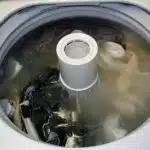As a laundry expert, I have often been asked about the most efficient and effective methods of washing clothes. While traditional washing machines have made laundry day much easier, they are not always accessible or affordable for everyone. In such cases, washing clothes in a bathtub can be a practical alternative.
Washing clothes in a bathtub is an age-old practice that has been used by people all over the world for centuries. It involves soaking dirty clothes in water mixed with detergent or soap and then agitating them manually to remove dirt and stains. This method requires very little equipment and can be done using basic household supplies. In this article, we will discuss how to wash clothes in a bathtub efficiently and effectively to achieve clean and fresh-smelling garments without the need for expensive machinery.
Preparing Your Clothes For Washing
Sorting clothes and pretreating stains are two important steps in preparing your clothes for washing in a bathtub. Sorting your clothes by color and fabric type will help prevent bleeding of colors and damage to delicate fabrics during the wash. Separate whites, darks, and colors, and be sure to check the care label on each item for specific washing instructions. Pay attention to items that require handwashing or dry cleaning only.
Pretreating stains is crucial in ensuring that your clothes come out clean after washing. Identify any stains on your clothes before putting them in the tub. Apply a stain remover or pre-treatment solution to the affected areas and let it sit for a few minutes before washing. Be careful not to use too much solution, as it may cause discoloration or damage to the fabric.
By following these simple steps of sorting clothes and pretreating stains, you can ensure that your clothes are properly prepared for washing in a bathtub. The next step is choosing the right detergent or soap that will effectively clean your clothes without causing damage. It’s important to consider factors such as fabric type, water hardness, and personal preferences when selecting a detergent or soap. Let’s explore this further in the next section.
Choosing The Right Detergent Or Soap
When it comes to washing clothes in a bathtub, choosing the right detergent or soap is crucial. This step can make or break the effectiveness of your laundry routine. To start with, it is important to understand the difference between soap and detergent. Soap is made from natural ingredients and is typically used for hand washing delicate fabrics. On the other hand, detergents are synthetic compounds that are formulated to remove dirt and stains from laundry.
Choosing eco friendly, cost effective detergents should be a priority when selecting what to use for your bathtub laundry routine. Eco-friendly options not only reduce harm to the environment but also contribute positively to your overall health by avoiding harsh chemicals that can cause skin irritation. Cost-effective detergents, on the other hand, help you save money in the long run as they require less product per wash.
It cannot be overstated how critical this step is in achieving clean laundry results when doing laundry in a bathtub. Understanding which detergent or soap works best for your fabrics and specific type of cleaning needed will lead to better outcomes and satisfaction with your laundry routine. With this knowledge at hand, let’s move onto filling up your bathtub with water.
Filling The Bathtub With Water
- The temperature of the water used for washing clothes in a bathtub should be appropriate for the fabric being washed.
- To maximize the effectiveness of the detergent, it should be added to the water before the clothes are added.
- The amount of water used to wash clothes in a bathtub should be sufficient to cover the clothes completely and allow them to move freely.
- Fabric softener can be added directly to the water or diluted with a small amount of water before being added to the bathtub.
- The amount of detergent and fabric softener used for washing clothes in a bathtub should be adjusted according to the amount of clothing being washed.
- To ensure optimal cleaning results, the water should be agitated periodically throughout the washing process.
Choosing The Right Water Temperature
When it comes to washing clothes in a bathtub, choosing the right water temperature is crucial. It can make all the difference in how clean your clothes get and how well they maintain their color and shape. As a laundry expert, I recommend using cold water for most clothing items, as it provides several benefits.
Firstly, using cold water helps to preserve the color of your clothes better than hot or warm water. The heat from hot or warm water can cause colors to fade and bleed, especially on delicate fabrics like silk or wool. Secondly, cold water prevents shrinkage and damage to synthetic materials like polyester or nylon. Hot water can cause these fabrics to warp and lose their shape over time.
However, not all clothes should be washed in cold water. If you are dealing with heavily soiled items such as bedding or towels, using warm or hot water may be necessary. In these cases, adjusting detergent amount is also important as too much detergent can leave residue on your clothes.
In conclusion, while cold water is generally the best option for washing clothes in a bathtub due to its benefits of preserving color and preventing shrinkage, there are certain situations where warmer temperatures may be necessary. By adjusting detergent amounts accordingly and being mindful of each garment’s specific care instructions, you can ensure that your laundry comes out looking clean and fresh every time.
Adding Detergent And Softener
Now that we have discussed the importance of choosing the right water temperature for washing clothes in a bathtub, let us move on to another crucial aspect – adding detergent and softener. Using these products correctly can help ensure that your clothes come out clean, fresh, and free from any odors or stains.
When it comes to adding detergent, it is important to use the correct amount. Too little detergent may not be enough to clean your clothes properly, while too much can leave residue on them. As a laundry expert, I recommend measuring out the detergent according to the packaging instructions and adjusting it based on the size of your load and level of soiling. This way, you can avoid wasting detergent and prevent any damage to your clothes.
Another thing to consider is using fabric softener alternatives instead of traditional fabric softeners. While they can make your clothes feel softer and smell pleasant, fabric softeners contain chemicals that can harm some fabrics over time. Instead, you can try using vinegar or baking soda as natural alternatives that work just as well without damaging your clothes.
In conclusion, adding detergent and softener is an essential part of washing clothes in a bathtub. By properly measuring detergent and using fabric softener alternatives, you can ensure that your laundry comes out smelling fresh and feeling soft without causing any damage to your favorite garments.
How Much Water To Use
Now that we have discussed the importance of choosing the right water temperature and adding detergent and softener, let us move on to another crucial aspect of washing clothes in a bathtub – how much water to use. As a laundry expert, I highly recommend using less water when filling your bathtub for washing clothes. Not only does this conserve water, but it also helps prevent damage to your clothing.
Water conservation techniques are essential not just for the environment but also for our pockets. Filling the bathtub with less water can help save money on utility bills while still efficiently washing clothes. However, it is important to note that using too little water can cause friction between fabrics, leading to wear and tear on your clothing. Therefore, you should always aim for a balance between conserving water and ensuring proper clothing care.
To determine how much water you need for each wash cycle, consider the size of your load and adjust accordingly. A general rule of thumb is to fill the tub with enough water so that your clothes can move freely without getting too bunched up or tangled. By following these basic guidelines, you can ensure that you are using just enough water to get your clothes clean without wasting any resources or causing unnecessary harm to your garments.
Adding The Detergent Or Soap To The Water
After filling the bathtub with water, it is time to add the detergent or soap in the right amount. It is important to use only the recommended amount of detergent for your clothes to avoid overuse. Overusing detergent can damage your clothes and cause skin irritation or allergies.
Using natural soap is a great alternative to commercial detergents. Natural soaps are made with organic ingredients and contain no harmful chemicals that could harm you or your clothes. They are also eco-friendly and biodegradable, making them a perfect choice for those who want to reduce their carbon footprint.
If you prefer making your own detergent at home, there are several recipes available online that you can try. You can use simple ingredients such as baking soda, vinegar, and essential oils to create a natural and effective detergent that will leave your clothes smelling fresh and clean. Making your own detergent is also more cost-effective than buying commercial ones, which can save you money in the long run.
As we have discussed, using the right amount of detergent or soap is crucial when washing clothes in a bathtub. Whether you choose a natural soap or make your own detergent at home, always follow the recommended measurements to avoid damaging your clothes or causing skin irritation. In the next section, we will discuss how to soak the clothes in the water properly before rinsing them out.
Soaking The Clothes In The Water
- Adding detergent to a bathtub full of water is an essential part of the washing process, as it helps to lift dirt and grime from the fabric of the clothes.
- Submerging clothes should always be done slowly and deliberately, to avoid damage to the material.
- After submerging the clothes in the water, it is important to agitate them to ensure even cleaning.
- Agitating clothes can be done manually by hand, or with a washing machine-style motion.
- When agitating clothes, care should be taken to ensure that the fabric does not become damaged or torn.
- As a general rule, clothes should be agitated for at least three minutes to ensure adequate cleaning.
Adding Detergent
When it comes to washing clothes in a bathtub, adding detergent is a crucial step that cannot be skipped. The right amount and type of detergent can make all the difference between clean and dingy clothes. As a laundry expert, I highly recommend using alternatives to traditional laundry detergents such as baking soda or vinegar. These options are not only effective in removing dirt and stains but are also eco-friendly.
When choosing a detergent for hand washing clothes in a bathtub, it is important to compare brands and their ingredients carefully. Look for products that are specifically designed for hand washing and mention gentle cleaning on their labels. Avoid using harsh detergents or bleach as they can damage fabrics and cause discoloration over time.
Remember to dissolve the detergent completely in water before adding clothes to the tub. This will ensure that each garment is evenly coated with soap and prevent any soap residue from being left behind after rinsing. By following these simple guidelines, you can achieve clean and fresh-smelling clothes without the need for a washing machine or dryer.
Submerging Clothes
After adding detergent to the water, the next step in hand washing clothes in a bathtub is to submerge them. Submerging clothes means fully immersing them in water so that every fiber is soaked and can be properly cleaned. This step is essential because it allows the detergent to penetrate deep into the fabric and remove all traces of dirt and grime.
The benefits of submerging clothes during hand washing are numerous. Firstly, it ensures that each garment gets an equal amount of attention, which is especially important for heavily soiled items. Secondly, submerging clothes helps keep their shape intact by preventing any twisting or bunching that can occur when agitating them manually.
To properly submerge clothes, you will need a large enough container such as a bathtub or sink that can hold enough water to cover the garments completely. It’s important to note that overcrowding the tub with too many clothes at once can make it difficult for them to move around freely and get clean. So be sure not to overload the tub and give each item enough space to move around.
In addition to an adequate container, you’ll also need equipment such as tongs or gloves to help you manipulate the garments without damaging them. These tools will allow you to gently lift and squeeze out excess water from each item before rinsing them thoroughly. By following these guidelines, you’ll achieve freshly laundered clothes that look and smell great without ever having to use a washing machine or dryer.
Agitating Clothes
After submerging the clothes in water, the next step is to agitate them. Agitation is the process of physically manipulating the garments to loosen and remove dirt and stains. This step is crucial because it helps break up any stubborn residues that may have been missed during soaking. There are several ways to agitate clothes, including using a plunger or creating a DIY washing machine.
Using a plunger is an effective method for agitating clothes when hand washing. Simply fill the tub with enough water to cover the garments, add detergent, and then use a clean plunger to push and pull the clothes up and down in the water for several minutes. This motion creates friction between the fabric fibers, which helps lift dirt from deep within each item.
Another way to agitate clothes is by creating a DIY washing machine. This method involves using a large container such as a bucket or plastic bin with a lid. Fill it with water and detergent, add your clothes, and then seal the lid tightly. Next, shake the container vigorously for several minutes until you feel confident that each garment has been thoroughly cleaned.
By following these guidelines on how to properly agitate your clothes during hand washing, you can achieve excellent results without ever having to use a washing machine or dryer. Remember that agitation should be done gently yet effectively so as not to damage your clothing items. With practice and patience, you’ll become an expert at hand washing laundry in no time!
Agitating The Clothes To Remove Dirt And Stains
Once you have filled the bathtub with water and added natural detergents, it’s time to start agitating the clothes. Agitation is an important part of washing clothes, as it helps remove dirt and stains that may be deeply ingrained in the fabric. Think of agitating your clothes like kneading dough; you need to work the fabric in a way that will evenly distribute the detergent and break up any dirt or grime.
To begin agitating your clothes, use your hands to create a swirling motion in the water. You can also try gently rubbing the fabric against itself or pressing down on areas that are particularly dirty. Hand agitating techniques are particularly useful for delicate fabrics that may not withstand machine washing. Be sure to pay extra attention to areas such as collars, cuffs, and hems where dirt tends to accumulate.
As you agitate your clothes, be mindful of how long you spend on each item. Over-agitation can cause damage to delicate fabrics or stretch out clothing over time. Additionally, make sure you take plenty of breaks if you’re washing a large load of laundry. Your arms will thank you! Once you feel confident that your clothes have been properly agitated, it’s time to move on to rinsing them thoroughly in clean water.
- Tips for Effective Hand Agitation:
- Use circular motions when swirling clothes in water
- Pay extra attention to heavily soiled areas
- Collars
- Cuffs
- Make sure to agitate all layers of fabric, including any pockets or folds.
Rinsing The Clothes Thoroughly
The next step in washing your clothes in a bathtub is to rinse them thoroughly. This is crucial as it helps to remove any remaining detergent and dirt from the fabric, leaving your clothes fresh and clean. When rinsing, ensure that you use enough water to cover all the clothes adequately.
After rinsing, it’s important to remove excess water from the clothes before drying them. You can do this by gently squeezing or pressing them against the side of the tub. However, avoid overloading the tub with too many clothes at once as this can make it difficult for you to rinse and wring out the excess water properly.
Once you have removed as much water as possible from your clothes, you can now proceed to dry them. The importance of drying cannot be overstated as it helps prevent mold and mildew growth on damp clothing. Additionally, proper drying ensures that your clothes maintain their shape and color. In the next section, we will discuss how to remove excess water from your clothes before proceeding to dry them thoroughly.
Removing Excess Water From The Clothes
After rinsing your clothes thoroughly, it is time to remove excess water from them. According to a survey conducted by the American Cleaning Institute, nearly 62% of Americans prefer using a washing machine for their laundry. However, there are still many who opt for handwashing and may not have access to a spin dryer or wringer.
If you do have access to a spin dryer or wringer, these are great options for removing excess water from your clothes quickly and efficiently. Simply place your clothes in the machine and let it do its job. If you don’t have access to either of these machines, towel drying can also be an effective method. Lay your clothes flat on a clean towel and roll it up tightly to squeeze out as much water as possible.
If air drying your clothes indoors is necessary, there are some tips you can follow. Hang your clothes in a well-ventilated area with good airflow. Avoid hanging them too close together as this can slow down the drying process. You can also use a fan or dehumidifier in the room to help speed up the process. And remember, always hang your clothes upside down as this will help prevent stretching and sagging.
When hang-drying your clothes outside, make sure to choose a sunny and windy day for optimal results. Use plastic or wooden hangers to avoid rust stains on lighter fabrics and avoid direct sunlight on darker items to prevent fading. With these tips in mind, you’ll be able to effectively dry your laundry without the need for expensive machines or equipment.
Hang-Drying Your Clothes
After washing your clothes in a bathtub, it’s important to properly hang-dry them to avoid damaging the fabric or causing wrinkles. Here are some tips for effective hang drying:
Choose the right location: Find a well-ventilated area that is not too humid or damp, and preferably out of direct sunlight to prevent fading of colors.
Use proper hangers: Use hangers that match the shape of the garment to prevent stretching and misshaping. For heavier items like jeans or jackets, use sturdy wooden hangers.
Separate delicate fabrics: Hang dry delicate fabrics separately from heavy or bulky items to avoid stretching or damage.
Shake out garments before hanging: Gently shake out each piece of clothing before hanging it up to remove any excess water and minimize wrinkles.
Avoiding common mistakes while hang drying is crucial for maintaining the quality of your clothes. Here are some things to keep in mind:
- Don’t overcrowd hangers: Give each garment enough space on the hanger to allow air flow and prevent wrinkles.
- Don’t hang wet clothes on wire hangers: The thin metal can leave marks on your clothes or even cause them to stretch out of shape.
- Don’t use a dryer rack or clothesline outdoors in direct sunlight: This can cause colors to fade and fabrics to become brittle over time.
- Don’t use bleach on clothes that will be hang dried: Bleach can weaken fibers and make them more prone to damage during drying.
By following these tips for effective hang drying and avoiding common mistakes, you can ensure that your clothes look their best for longer. In the next section, we will discuss some tips for washing delicate fabrics without causing damage.
Tips For Washing Delicate Fabrics
When it comes to washing delicate fabrics, it is important to take extra care and precautions. Delicate fabrics are often made from materials such as silk, lace, or cashmere that require special treatment. Improper washing techniques can cause damage to the fabric, resulting in shrinkage, discoloration, or even holes. To avoid any mishaps, follow these tips for washing delicate fabrics.
Firstly, delicate fabric storage is crucial for maintaining the quality of the material. Store your delicates in a clean and dry area, away from direct sunlight or heat sources. Hanging your clothes on hangers can help prevent wrinkles and creases. Additionally, avoid overcrowding your closet or drawer as this can lead to unnecessary stretching of the fabric.
Secondly, choosing the right washing temperature is important when dealing with delicate fabrics. Always check the care label before washing to determine the appropriate temperature setting. Generally speaking, cold water is recommended for delicates as it helps preserve the color and texture of the fabric while preventing shrinkage. If your delicates require warm water for cleaning purposes, be sure not to exceed 30°C (86°F).
Lastly, here is a table outlining some common delicate fabrics and their corresponding care instructions:
| Fabric | Care Instructions |
|---|---|
| Silk | Hand wash in cold water; air-dry away from direct sunlight |
| Lace | Machine wash using a gentle cycle; air-dry flat |
| Cashmere | Hand wash in cold water; lay flat to dry |
By following these guidelines for washing delicate fabrics and paying close attention to storage and temperature settings, you can ensure that your clothing stays looking its best for longer periods of time. In the next section, we will go over tips for how to handle tough stains on clothing without damaging delicate fabrics.
How To Handle Tough Stains
Effective stain removal is a crucial part of the laundry process. Stains can come in many different forms, from food to grease to sweat. It is important to know how to handle tough stains so that your clothes look clean and fresh every time you wear them. There are several natural stain fighting remedies that can be used to remove even the toughest stains.
One effective natural remedy for tough stains is white vinegar. Simply mix equal parts vinegar and water and apply the mixture directly onto the stained area. Let it sit for at least 10 minutes before washing as usual. Another great natural remedy is baking soda. Mix a small amount of baking soda with water to create a paste and apply it directly onto the stain. Let it sit for at least 30 minutes before washing.
For really tough stains such as blood or red wine, hydrogen peroxide can be very effective. Apply a small amount of hydrogen peroxide directly onto the stain and let it sit for about five minutes before washing as usual. It is important to remember not to mix hydrogen peroxide with other cleaning products, as this can cause dangerous chemical reactions.
Effective stain removal is an essential part of all laundry routines. By using natural stain fighting remedies such as white vinegar, baking soda, and hydrogen peroxide, even the toughest stains can be removed without damaging your clothes. In the next section, we will discuss how to wash clothes while traveling without access to a washing machine or dryer.
Washing Clothes While Traveling
- Preparing for a trip by packing the right laundry supplies is essential for washing clothes on the go.
- A good selection of supplies includes laundry detergent, fabric softener, a laundry bag, and a drying rack.
- Washing clothes in a bathtub requires several steps, such as filling the tub with water and adding detergent, before agitating the clothes.
- After washing, the clothes should be rinsed and spun in a washing machine, and then dried using the drying rack or hung on a line.
Packing Laundry Supplies
Packing laundry supplies can be a daunting task, especially when you have limited space in your luggage. As an expert in the laundry industry, I recommend using space-saving tips to ensure that you have ample room for all your essentials. One of the best ways to save space is by packing multi-purpose products such as detergent pods and stain remover wipes. You can also opt for smaller containers of laundry soap or fabric softener instead of bulky ones.
Another option for eco-conscious travelers is to pack eco-friendly laundry supplies. These products are not only better for the environment but also for your skin. Some examples of eco-friendly laundry products include natural detergents, reusable dryer sheets, and wool dryer balls. Not only do they take up less space, but they also reduce waste and are often more cost-effective in the long run.
When packing your laundry supplies, remember to prioritize based on your needs and travel plans. If you’re going on a short trip, focus on essentials like detergent and stain remover wipes. For longer trips or if you plan on doing multiple loads of laundry, consider bringing additional items like fabric softener or dryer balls. By following these tips, you’ll be able to efficiently pack your luggage with all the necessary items while still being mindful of the environment and saving space.
Washing Clothes On The Go
As a laundry expert, I understand the challenges of washing clothes while on the go. Whether you’re backpacking through Europe or taking a road trip across the country, finding a convenient and affordable way to wash your clothes can be a daunting task. However, with some laundry hacks and portable washing machines, you can make the process much easier.
One of the best laundry hacks for washing clothes on the go is to bring a portable washing machine. These compact devices are designed specifically for travelers and can easily fit in your luggage. They are lightweight, easy to use, and don’t require any electricity or plumbing. Simply add water, detergent, and your dirty clothes, then let the machine do its work. With a portable washing machine, you can get fresh and clean clothes without having to find a laundromat or pay for expensive hotel services.
If bringing a portable washing machine isn’t an option for you, there are other laundry hacks that you can use to wash your clothes on the go. One popular method is handwashing using biodegradable soap and a sink or bathtub. This method is affordable and eco-friendly but requires more effort than using a portable washing machine. Another option is to take advantage of local laundry services like drop-off wash-and-fold or coin-operated machines.
In conclusion, whether you choose to bring a portable washing machine or use other laundry hacks like handwashing or local services, it’s important to plan ahead before embarking on your travels. By being prepared with the right supplies and knowing where to find reliable washing options along your journey, you can ensure that your clothes stay clean and fresh no matter where your adventures take you.
Saving Money And Energy With Bathtub Washing
Imagine if you could save money and energy while doing your laundry. It may sound impossible, but it is achievable with bathtub washing. By using natural detergents and water conservation techniques, you can ensure that your clothes are clean without harming the environment or breaking the bank.
One way to conserve water is by reusing it. After washing your clothes in a bathtub, use the same water to scrub down your bathroom walls or floors. This not only saves water but also eliminates the need for harsh chemicals that harm both you and the environment. Additionally, using natural detergents such as vinegar, baking soda, or lemon juice can reduce chemical exposure and prevent skin irritation.
Another technique is to use a washboard or agitator to help remove dirt and grime from your clothes. These tools allow for more effective cleaning without requiring excessive amounts of water or energy. By taking these steps, you can reduce your environmental impact while still achieving clean laundry.
Transitioning into troubleshooting common issues: While bathtub washing is an effective way to save money and energy on laundry, there may be some common issues that arise during the process. Let’s explore how to address these problems without compromising on cleanliness or sustainability.
Troubleshooting Common Issues
Common issues can arise when attempting to wash clothes in a bathtub. One of the most common problems is that the clothes may not be getting clean enough. This can occur if there is not enough water in the bathtub or if the detergent is not being distributed evenly throughout the clothes. To solve this issue, it is best to make sure that there is enough water in the tub to completely cover the clothes and to mix the detergent with some water before pouring it over the clothes.
Another issue that can occur when washing clothes in a bathtub is that they may not be rinsed properly. This can cause soap residue to be left on the clothes, which can lead to skin irritation or damage to delicate fabrics. To avoid this problem, it is important to thoroughly rinse each item of clothing after washing it. Best practices suggest filling up a bucket with clean water and using it to rinse each item thoroughly before wringing them out and hanging them up to dry.
Lastly, sometimes people find that their clothes are taking too long to dry after being washed in a bathtub. Common solutions include squeezing out as much water as possible from each garment before hanging them up to dry. Additionally, it may be helpful to hang items near a window or fan for increased air circulation and faster drying times. By following these best practices, you should have no trouble washing your laundry in a bathtub.
To explore alternatives for washing laundry without using a bathtub, there are many other options available including using a washing machine or visiting a laundromat. These alternatives offer more efficiency than hand-washing and also provide access to machines designed specifically for laundry care. In addition, laundromats often have larger machines which are ideal for bulkier items such as comforters or blankets.
Alternatives To Bathtub Washing For Laundry
Like a tree with numerous branches, the world of laundry is vast and full of alternatives to washing clothes in a bathtub. These alternatives have been developed over time to cater to those who prefer a more sustainable and eco-friendly way of cleaning their clothes. One such method is hand washing, which involves using your hands instead of a machine or tub.
Hand washing is an effective alternative to bathtub washing and involves soaking the clothes in soapy water before agitating them manually. It requires less water than a machine or tub and can be done in any sink or basin. Additionally, it allows for more control over the cleaning process, ensuring that stains are removed from specific areas.
Another option available for those seeking laundry alternatives is air-drying. This method involves hanging your clothes outside on a line or indoors on a drying rack after they have been washed. Air-drying not only saves energy but also prevents shrinkage, helps extend the lifespan of clothing, and eliminates the need for fabric softeners.
Sustainable washing methods like hand-washing and air-drying may take longer than traditional methods, but they are kinder on both your wallet and the environment. By opting out of using traditional machines or bathtubs, you contribute to reducing carbon emissions associated with energy consumption while still achieving clean laundry results. So go ahead; try out these alternatives today!
Conclusion
Washing clothes in a bathtub can be an effective and low-cost way to do laundry, particularly when traveling or trying to save money on energy bills. To get started, prepare your clothes by sorting and pre-treating any stains. Choose a suitable detergent or soap based on the material of your clothing and fill the bathtub with enough water to cover all items.
Once you have added the detergent or soap, let your clothes soak for at least 30 minutes before gently agitating them with your hands. Rinse the clothes thoroughly and hang dry if possible. It is important to troubleshoot common issues such as excess soap residue or wrinkling to ensure that your clothes are cleaned effectively.
According to a study conducted by the American Cleaning Institute, 65% of people do laundry once a week, with an average of six loads per week. With increasing concerns about sustainability and conservation of resources, bathtub washing can be a viable alternative that saves both water and energy. As laundry experts, we encourage individuals to explore different options for doing laundry that align with their values and priorities. By following these simple steps, bathing your clothes can be an efficient and eco-friendly way to keep them clean.
Image Credits
- “giant bathtub” by Erica Nicol (featured)












![How To Wash And Care For White Clothes 12 The only genuine borax soap cleanses hygienically saves the clothes and hands. 20 Mule-Team brand Boraxo white laundry soap [front]](https://green-life.blog/wp-content/uploads/2023/05/YDXLLCovnOjq-150x150.jpg.webp)
















